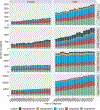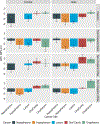Disparities in head and neck cancer incidence and trends by race/ethnicity and sex
- PMID: 36200577
- PMCID: PMC9742317
- DOI: 10.1002/hed.27209
Disparities in head and neck cancer incidence and trends by race/ethnicity and sex
Abstract
Background: The epidemiology of head and neck cancer (HNC) sites differ substantially. This study compares HNC incidence trends by site and demographic subgroups.
Methods: We used the U.S. Cancer Statistics Public Use Database to calculate HNC incidence rates per 100 000. We assessed trends with annual percent change (APC) longitudinally from 2001 to 2017.
Results: The oropharyngeal cancer incidence APC decreased from 4.38% (95% CI: 3.6, 5.1) to 2.93% (2.5, 3.3) in 2008 among White males. Oral cavity cancer incidence rose in Other race males (APC 2.5% [1.6, 3.36]) and White females (APC: 0.96% [0.7, 1.2]). Although decreasing (APC: -1.15% [-1.48, -0.83]), laryngeal cancer incidence remained disproportionately high among Black males.
Conclusions: Notable incidence trends occurred in non-White groups at non-oropharyngeal sites. With parity of smoking rates by race, differing sexual behaviors, and shifting demographics by race and sex, future studies of HNC trends should consider stratifying analyses to understand health disparities.
Keywords: demographic disparities; epidemiology; head and neck cancer; incidence; otolaryngology.
© 2022 Wiley Periodicals LLC.
Conflict of interest statement
Figures
Similar articles
-
Examining the incidence of human papillomavirus-associated head and neck cancers by race and ethnicity in the U.S., 1995-2005.PLoS One. 2012;7(3):e32657. doi: 10.1371/journal.pone.0032657. Epub 2012 Mar 20. PLoS One. 2012. PMID: 22448226 Free PMC article.
-
Rising incidence of late-stage head and neck cancer in the United States.Cancer. 2020 Mar 1;126(5):1090-1101. doi: 10.1002/cncr.32583. Epub 2019 Nov 13. Cancer. 2020. PMID: 31722124
-
Temporal trends in oropharyngeal cancer incidence, survival, and cancer-directed surgery among elderly Americans.Oral Oncol. 2022 Nov;134:106132. doi: 10.1016/j.oraloncology.2022.106132. Epub 2022 Sep 30. Oral Oncol. 2022. PMID: 36191478
-
The Health System and Policy Implications of Changing Epidemiology for Oral Cavity and Oropharyngeal Cancers in the United States From 1995 to 2016.Epidemiol Rev. 2017 Jan 1;39(1):132-147. doi: 10.1093/epirev/mxw001. Epidemiol Rev. 2017. PMID: 28402398 Review.
-
Global incidence trends in head and neck cancer for HPV-related and -unrelated subsites: A systematic review of population-based studies.Oral Oncol. 2021 Apr;115:105177. doi: 10.1016/j.oraloncology.2020.105177. Epub 2021 Feb 6. Oral Oncol. 2021. PMID: 33561611
Cited by
-
Trends in Human Papillomavirus Testing Among Patients With Oropharyngeal Cancer.JAMA Netw Open. 2025 Jul 1;8(7):e2523917. doi: 10.1001/jamanetworkopen.2025.23917. JAMA Netw Open. 2025. PMID: 40728789 Free PMC article.
-
Examination of Predictors of Pain at 12 Months Postdiagnosis in Head and Neck Cancer Survivors.Otolaryngol Head Neck Surg. 2023 Dec;169(6):1506-1512. doi: 10.1002/ohn.416. Epub 2023 Jul 5. Otolaryngol Head Neck Surg. 2023. PMID: 37403789 Free PMC article.
-
Risk of head and neck cancer in relation to blood inflammatory biomarkers in the Swedish AMORIS cohort.Front Immunol. 2023 Oct 9;14:1265406. doi: 10.3389/fimmu.2023.1265406. eCollection 2023. Front Immunol. 2023. PMID: 37876941 Free PMC article.
-
Deep learning algorithm performance in contouring head and neck organs at risk: a systematic review and single-arm meta-analysis.Biomed Eng Online. 2023 Nov 1;22(1):104. doi: 10.1186/s12938-023-01159-y. Biomed Eng Online. 2023. PMID: 37915046 Free PMC article.
-
Disparities in Care for Patients with Head and Neck Cancer.Surg Oncol Clin N Am. 2024 Oct;33(4):669-681. doi: 10.1016/j.soc.2024.04.010. Epub 2024 Jun 4. Surg Oncol Clin N Am. 2024. PMID: 39244286 Review.
References
-
- Chow LQM. Head and Neck Cancer. N Engl J Med. 2020;382(1):60–72. - PubMed
-
- Chang ET, Adami HO. The enigmatic epidemiology of nasopharyngeal carcinoma. Cancer Epidemiol Biomarkers Prev. 2006;15(10):1765–1777. - PubMed
-
- Altieri A, Bosetti C, Gallus S, et al. Wine, beer and spirits and risk of oral and pharyngeal cancer: a case-control study from Italy and Switzerland. Oral Oncol. 2004;40(9):904–909. - PubMed
MeSH terms
Grants and funding
LinkOut - more resources
Full Text Sources
Medical




